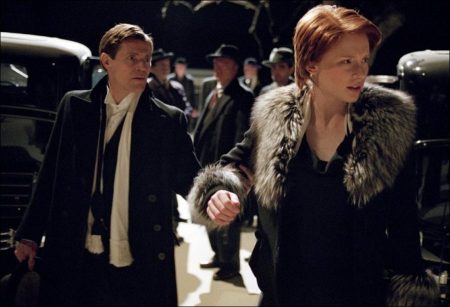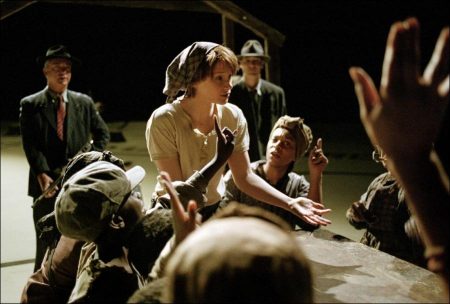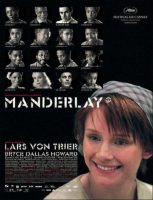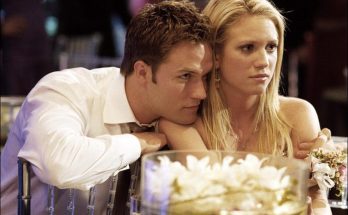Taglines: A case of mistaken identity.
After gangster Mulligan’s cars colony, fleeing northern justice, finds a hiding place in Alabama, spoiled, naive daughter Grace refuses to travel on after seeing the Manderlay cotton plantation being run under slavery rules, called Mam’s law, inclusive flogging. She keeps half of dad’s goons as guard to force the dying matriarch-owner’s heirs, which she shamelessly dispossesses and reduces to ‘staff’, to taste destitution under absurd, gun-imposed contracts.
The ‘slaves’ are made free partners, supposed to vote for progress after lessons from Grace. But almost all her democracy-pupils prove fickle, dumb and selfish, except old Willem. Her and their ignorance in Southern planting and crafty Dixie ways means more problems are created then solved. By the time dad returns to pick her up or abandon her for good, she’s the one who has learned and changed the most.
Manderlay is a 2005 internationally co-produced avant-garde drama film written and directed by Lars von Trier and the second part of von Trier’s projected USA – Land of Opportunities trilogy. It stars Bryce Dallas Howard, who replaces Nicole Kidman in the role of Grace Mulligan. The film co-stars Willem Dafoe, replacing James Caan. Lauren Bacall, Željko Ivanek, Jeremy Davies, and Chloë Sevigny return portraying different characters from those in Dogville. Only John Hurt, Udo Kier, and Jean-Marc Barr reprise their roles.
The staging is very similar to Dogville. The film was shot on a sparsely dressed sound stage. As in the case of Dogville, Manderlay’s action is confined to a small geographic area, in this case a plantation. The film did not perform well at the box-office, taking a total of only $674,918. Compared to its production budget of $14.2 million, this makes it a box office bomb.
About the Story
It is 1933, in Alabama. Manderlay is a plantation where a group of people are living as if slavery hadn’t been abolished 70 years earlier. Upon leaving Dogville in 1933, Grace and her father head far south to the state of Alabama where they arrive upon the bizarre place.
The second installment in Lars von Trier’s “USA — Land of Opportunities” trilogy. Dafoe will play the father of Grace, the central character played by Nicole Kidman in the series’ first film, “Dogville,” and played by Bryce Dallas Howard in “Manderlay”. The film, shot entirely on a stage, is set in the American South during the 1930s and explores the repression of blacks.
This is the strange, disturbing story of the Manderlay plantation. Manderlay lay on a lonely plain somewhere in the deep south of the USA. It was in the year of 1933 that Grace and her father had left the township of Dogville behind them, with Grace’s unforgettable verdict: ‘If there is any town the world would be a little better without, this is it’; and had driven homewards towards the city of Denver. But being away from home is a serious matter in the gangster business, and the mice had been well and truly playing while the cat was away.
Grace’s father and his army of villains had spent the entire winter seeking out new hunting grounds in vain, and now, in this early month of spring, they are driving south in one last attempt to find a favourable location in which to take up residence. By chance their cars stop in the State of Alabama in front of a large iron gate bearing a thick chain and a padlock. Beside the gate a dead oak tree towers over a heavy boulder with Manderlay hewn in monumental letters into the granite.
Just as Grace, her father and his men are about to leave after a short break and a quick lunch, a young black woman runs up to the car. She knocks on Grace’s window. She hammers at the glass in despair. Grace gets out of the car, and ignoring the distinct advice of her father she follows the girl through the gates of Manderlay, and there she finds a group of people living as if slavery had not been abolished seventy years earlier, with white masters and black slaves.
Grace decides to intervene, despite the tentative warnings of the old house-slave Wilhelm, who sums up his fears for the future when he says: ‘At Manderlay we slaves take supper at seven; when do people eat when they are free?’ Grace can hardly believe what she now sees in the yard at Manderlay. A young black man, Timothy, has been tied between two fence posts for a whipping by a white overseer, Stanley Mays.
Grace orders him to desist, only to be confronted by the owner of the plantation, an elderly lady known as Mam, who points a shotgun at her. Her father’s henchmen take control of the situation. Mam, it turns out, is weak and dying. In her bedroom she begs Grace, as woman to woman and for the good of all, to destroy an old book hidden under her mattress.
Grace refuses to grant her wish. Mam dies and Grace discovers that the plantation has been run according to this handwritten book, Mam’s Law, seemingly a code of conduct and a dehumanised chronicle purporting to detail the appearance and behaviour of generations of slaves at Manderlay.
Manderlay (2006)
Directed by: Lars von Trier
Starring: Bryce Dallas Howard, Lauren Bacall, Willem Dafoe, Danny Glover, Udo Kier, Chloë Sevigny, Stellan Skarsgård, Lauren Bacall, Geoffrey Bateman, Jeremy Davies, Llewella Gideon
Screenplay by: Lars von Trier
Cinematography by: Anthony Dod Mantle
Film Editing by: Molly Marlene Stensgaard
Costume Design by: Manon Rasmussen
Set Decoration by: Simone Grau Roney
Art Direction by: Peter Grant
Music by: Joachim Holbek
Distributed by: IFC Films
Release Date: February 3, 2006
Visits: 40





